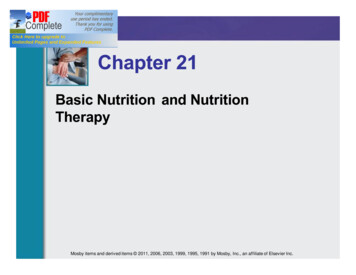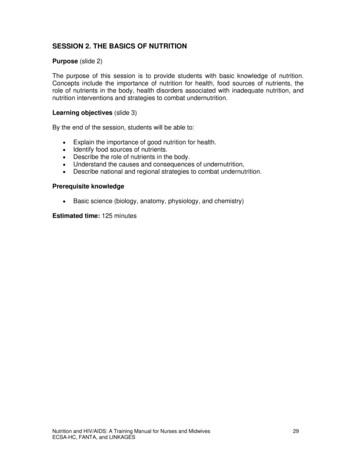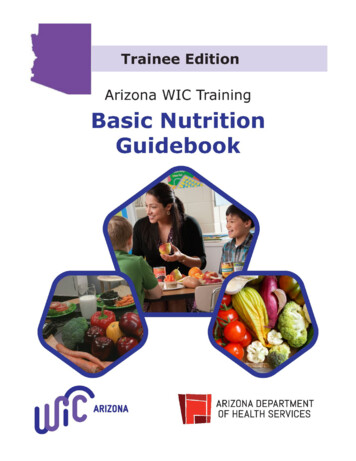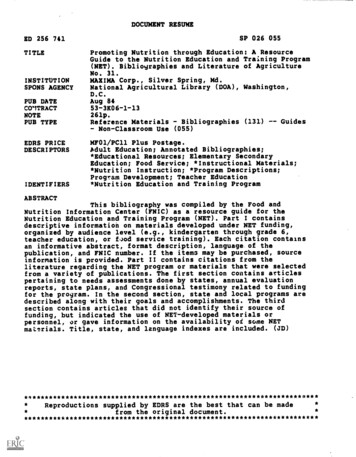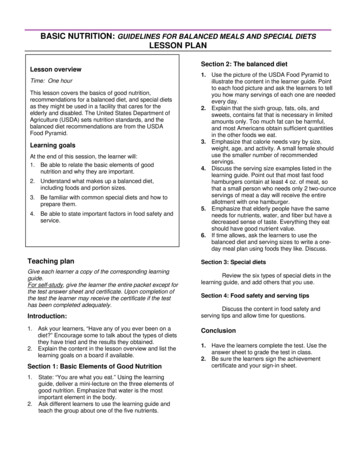
Transcription
Chapter 21Basic Nutrition and NutritionalTherapy1Mosby items and derived items 2006, 2003, 1999, 1995, 1991 by Mosby, Inc.Slide 1Basic Nutrition and NutritionalTherapy Nutrition is the total of all processesinvolved in the taking in and utilization offood substances for proper growth,functioning, and maintenance of health.Mosby items and derived items 2006, 2003, 1999, 1995, 1991 by Mosby, Inc.Slide 2Role of the Caregiver in PromotingNutrition The PT can promote good nutrition by Importance of the diet and encouraging dietarycompliance Assisting some patients with the eating process Taking and recording patient weight Recording patient intake Observing clinical signs of poor nutrition andreporting them Serving as a communication linkMosby items and derived items 2006, 2003, 1999, 1995, 1991 by Mosby, Inc.Slide 31
Old Food PyramidMosby items and derived items 2006, 2003, 1999, 1995, 1991 by Mosby, Inc.Slide 4Figure 21-1(From US Department of Agriculture, Washington, DC, 2005, US Government Printing Office.)MyPyramid, a personalized guide to daily food choices and numberof servings.Mosby items and derived items 2006, 2003, 1999, 1995, 1991 by Mosby, Inc.Slide 5Basic Nutrition The six classes of essential nutrients are Carbohydrates Proteins Fats Vitamins Minerals WaterMosby items and derived items 2006, 2003, 1999, 1995, 1991 by Mosby, Inc.Slide 62
Essential Nutrients TWO Basic Functions Provide energy Build and repair tissue Protein, calcium, phosphorus, iron,and fatMosby items and derived items 2006, 2003, 1999, 1995, 1991 by Mosby, Inc.Slide 7Carbohydrates Main function of carbohydrates is toprovide energy. Breaks down intoglucose. (sugar)Mosby items and derived items 2006, 2003, 1999, 1995, 1991 by Mosby, Inc.Slide 8Carbohydrates If energy needs are met, carbohydrateswill be stored as glycogen. Once glycogen stores are full, furtherexcesses of carbohydrates will beconverted to fat and stored as adiposetissue.Mosby items and derived items 2006, 2003, 1999, 1995, 1991 by Mosby, Inc.Slide 93
Fats Adipose tissue is the body’s storage formof fat; it helps insulate the body fromtemperature extremes and serves as acushion to protect organs and othertissues. Fat provides satiety; it adds flavor andaroma to foods.Mosby items and derived items 2006, 2003, 1999, 1995, 1991 by Mosby, Inc.Slide 10 Saturated fatty acids These are generally of animal origin They increase blood cholesterol levels and therisk of atherosclerosis.Mosby items and derived items 2006, 2003, 1999, 1995, 1991 by Mosby, Inc.Slide 11Unsaturated fatty acids They can be monounsaturated orpolyunsaturated. They usually are from plant sources They are thought to have a bloodcholesterol lowering effect at moderate levelsof intake.Mosby items and derived items 2006, 2003, 1999, 1995, 1991 by Mosby, Inc.Slide 124
Cholesterol Provides no energy. It is found in foods of animal origin. Dietary cholesterol is highest in organmeats and egg yolks. Intake of dietary cholesterol shouldaverage no more than 300 mg per day.Mosby items and derived items 2006, 2003, 1999, 1995, 1991 by Mosby, Inc.Slide 13Protein Protein makes up the bulk of the body’smuscle tissues and organs. It is necessary for tissue growth and repairand wound healing. There are 22 amino acids, 9 essentialamino acids must be obtained from thediet. Generally of animal origin; found infoods such as meat, poultry, fish, milk,cheese, and eggsMosby items and derived items 2006, 2003, 1999, 1995, 1991 by Mosby, Inc.Slide 14MarasmusMosby items and derived items 2006, 2003, 1999, 1995, 1991 by Mosby, Inc.Slide 155
Mosby items and derived items 2006, 2003, 1999, 1995, 1991 by Mosby, Inc.Slide 16Protein : Vegetarian Diets They are made up of mainly plant foods; somemay include dairy products or eggs as well. Lactovegetarin diet includes fruits,vegetables, grains, and milk and dairyproducts. Lacto-ovo-vegetarian diet also includeseggs. Protein needs can be met with avegetarian diet; a wide variety of plantfoods must be included.Mosby items and derived items 2006, 2003, 1999, 1995, 1991 by Mosby, Inc.Slide 17Vitamins and Minerals Fat soluble A, D, E, and K Usually carried in the fatty portion of food Can be stored by the body Water soluble B vitamins and C Not stored in the body; excesses excretedin the urineMosby items and derived items 2006, 2003, 1999, 1995, 1991 by Mosby, Inc.Slide 186
Vitamins (continued) Antioxidant vitamins Vitamins E and C Possible link to reduced risks of certaincancers and heart disease Function by delaying or preventing thedestruction or breakdown of cellmembranes in the presence of oxygen Vitamin C Adequate amounts are necessary for properimmune function.Mosby items and derived items 2006, 2003, 1999, 1995, 1991 by Mosby, Inc.Slide 19Vitamin D Most common dietary sources includefortified milk and milk products. The body can also make vitamin D fromexposure to sunlight. Promotes bone formation Deficiencies can lead to bone softeningdiseases Since 1930 each quart of milk has beenfortified with an additional 10 mg of vitaminD and since that time rickets, a major healthproblem, ended. Mosby items and derived items 2006, 2003, 1999, 1995, 1991 by Mosby, Inc.Mosby items and derived items 2006, 2003, 1999, 1995, 1991 by Mosby, Inc.Slide 20Slide 217
Vitamins and Minerals Vitamin K It plays a role in blood clotting. A large fluctuation in vitamin K intake mayalter the effects of anticoagulation drugs. Folate (folic acid) Before and during pregnancy, it plays a rolein reducing the risk of neural tube defects inthe infant. 2500-3000 infants/yr AnemiaMosby items and derived items 2006, 2003, 1999, 1995, 1991 by Mosby, Inc.Slide 22Spina bifadaMosby items and derived items 2006, 2003, 1999, 1995, 1991 by Mosby, Inc.Slide 23Vitamin B12 It is primarily found in foods of animalorigin. Strict vegans need to take B-12supplement It requires a special intrinsic factorproduced in the stomach for absorption. Pernicious anemia may result withinadequate amounts of intrinsic factorbecause B12 is not absorbed. Maintains myelin sheath, insultingcovering of nerveMosby items and derived items 2006, 2003, 1999, 1995, 1991 by Mosby, Inc.Slide 248
Minerals Major minerals are those needed in amountsgreater than 100 mg per day: calcium,phosphorus, magnesium, sulfur, sodium,potassium, and chloride. Trace minerals are needed in much smalleramounts: iron, zinc, iodine, selenium, copper,fluoride, chromium, and molybdenum.Mosby items and derived items 2006, 2003, 1999, 1995, 1991 by Mosby, Inc.Slide 25Minerals Calcium Protective effect against osteoporosis andhypertension Sodium Functions as an electrolyte Salt is a major dietary source Potassium An electrolyte; may have a protective effectagainst hypertension 2000 mg per day Iron Part of hemoglobin, which is part of the redblood cell and carries oxygen to the cellsMosby items and derived items 2006, 2003, 1999, 1995, 1991 by Mosby, Inc.Slide 26WATERMosby items and derived items 2006, 2003, 1999, 1995, 1991 by Mosby, Inc.Slide 279
How long can you live without water 3 to 4 days regardless of yoursize If you have food and not wateryou can survive for weeksMosby items and derived items 2006, 2003, 1999, 1995, 1991 by Mosby, Inc.Slide 28Water Nutrient most vital to life Makes up approximately 60% of adult bodyweight and 80% of infant weight Provides form and structure to body tissues Transports nutrients and other substances Lubricates and protects moving parts of thebody Lubricates food and aids in digestion Regulates body temperatureMosby items and derived items 2006, 2003, 1999, 1995, 1991 by Mosby, Inc.Slide 29Life Cycle Nutrition Adulthood Nutritional concerns of adults inlong-term care facilities Malnutrition is a common problem among nursinghome residents and profoundly influences physicalhealth and quality of life. Residents should be offered familiar foods that tastegood. Fluids should be offered to residents at all meals andbetween meals. Nurses must understand the value of mealtime as apleasant, social experience.Mosby items and derived items 2006, 2003, 1999, 1995, 1991 by Mosby, Inc.Slide 3010
Life Cycle Nutrition Nutrient-Drug Interactions Drugs may alter food intake by either increasing ordecreasing appetite or the ability to eat. They may also affect the absorption, metabolism,and excretion of certain nutrients. Food intake and vitamin/mineral supplementationmay affect the absorption, distribution, metabolism,and action of some medications.Mosby items and derived items 2006, 2003, 1999, 1995, 1991 by Mosby, Inc.Slide 31Therapeutic Diets Liquid diets Clear liquid diet: easily digested and absorbed.bouillon, broth Full liquid diet is more nutritionally complete than aclear liquid diet but is still lacking in some nutrients:strained cereals and soups, ice cream, puddings,milk/milkshakes, and fruit juices Soft and low-residue diets Soft diet : low in fiber; pureed Low-residue diet is similar to the soft diet but alsoincludes restrictions on milk, because it leaves moreresidue in the colon. Mechanical soft diet eliminates foods that aredifficult to chew or swallow.Mosby items and derived items 2006, 2003, 1999, 1995, 1991 by Mosby, Inc.Slide 32Therapeutic Diets High-Fiber Diets doubles the intake of dietary fiber. Used for the treatment of some GI disorders. High-kilocalorie and high-protein diets During times of physiological stress, the body’senergy and protein needs are increased. Diet should provide increased amounts of kilocaloriesand protein in small volumes. Nutritional support in the form of tube feedings or IVfeedings may be considered.Mosby items and derived items 2006, 2003, 1999, 1995, 1991 by Mosby, Inc.Slide 3311
Medical Nutrition Therapy andTherapeutic Diets Carbohydrate-Modified Diets Lactose Intolerance Intolerance occurs as a result of a lack of thedigestive enzyme lactase. The GI tract is unable to break down lactose. Symptoms occur after the ingestion of milk productsand include nausea, cramps, bloating, flatulence, anddiarrhea. Diet for lactose intolerance excludes milk and milkproducts; foods with milk added may need to beavoided as well.Mosby items and derived items 2006, 2003, 1999, 1995, 1991 by Mosby, Inc.Slide 34Parenteral Nutrition Support intravenous feedings May be administered through peripheral veins Total parenteral nutrition (TPN) Administration of hypertonic solution into a largecentral vein Composed of glucose, amino acids, vitamins,minerals, and electrolytes; fats also given as asupplement to the main formula Indicated for the patient with a nonfunctioningor dysfunctional GI tractMosby items and derived items 2006, 2003, 1999, 1995, 1991 by Mosby, Inc.Slide 35Time for lunchMosby items and derived items 2006, 2003, 1999, 1995, 1991 by Mosby, Inc.Slide 3612
3 Mosby items and derived items 2006, 2003, 1999, 1995, 1991 by Mosby, Inc. Slide 7 Essential Nutr


